Portrait of a Cruiser: Sam and Adrian Wood
Sam and Adrian Wood, both qualified skippers, have subsidized their last decade of cruising with delivery and charter work. After leaving the UK in 2011 for an Atlantic Circuit, the couple have still not returned home and are currently based in the Caribbean.
Published 4 years ago
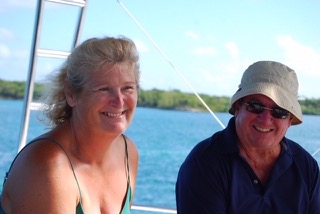

Sam and Adrian Wood (Joint Owners)
Nationality: British
Boat Name: Neva
Boat Type/Model and Size:
Slocum 43, 43ft
Home Port: Plymouth, England
Facebook: Samantha Wood
How did you start cruising?
Ade has sailed from the age of about 8, but Sam, in spite of being a Channel Islander, had never sailed until we met in 2007. We married 2009 and one wet and windy November night in Wiltshire Sam asked Ade what he wanted to do! Ade for some unknown reason said “a North Atlantic Circuit”. The next question was “How do we do that?” Well, that was it! We spent six months boat hunting, and finally settled on a Contessa 32, that venerable cruiser racer from the ‘70s.
We bought “Blue Moon” in 2010, sailed her that year, then refitted her completely in Plymouth over the winter before sailing up to the Solent for the 40th Anniversary celebrations of the Contessa 32 Class Association. On the 21 June 2011 we left via the Needles on a very misty morning to France and beyond. Little did we think on that morning that we would not return to live in England. We sold Blue Moon in Sint Maarten and bought our present boat in Marmaris in 2015.

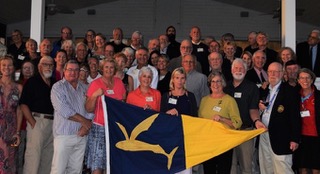
- Sam and Ade at the OCC dinner at Mahews Town VA.
Describe what sort of cruiser are you: Liveaboards
What type of cruising are you doing currently?
We are currently in the Caribbean, having spent the summer of 2019 cruising the US East Coast. We earn our living as professional yachtsmen, and have run a 75ft modern classic, charter catamarans in the Caribbean and sailed many miles delivering a wide variety of sailing yachts.
We have been sitting out the COVID-19 restrictions in Puerto Rico doing a number of delivery jobs from the Caribbean.

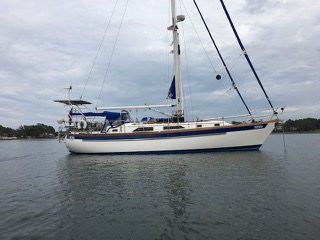
- Neva at anchor in Fishing Bay, Deltaville, VA
What were the key reasons you selected your current boat:
Pure chance!! We were refitting a yacht in Turkey for the owner. We took a weekend off to do a little exploring of that amazing country, but of course found ourselves in a boatyard in Marmaris looking at boats. Neva was sitting in the yard with a “For Sale” on her. We researched the type and the history of Neva, then decided she was worth having a proper look over.
She had been sitting ashore for nearly six years, and obviously we were going to have to completely refit her. We put in an offer that reflected her condition subject to survey and in March 2015 she became ours.
We should explain some of the features which made her ideal for our plans. We have to say that she was a little larger than we were planning on, but we have no regrets five years on.
Her accommodation is designed for a couple with occasional visitors. She has huge water and fuel tanks, and more storage than we need. She is cutter rigged, with oversized rigging and associated fittings. We were also fortunate that the first owner was obviously an experienced yachtsman and had her built with the options suitable for self sufficient Blue Water cruising.
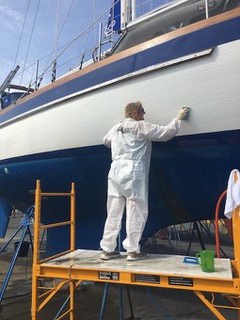

Both: Contessa 32, Blue Moon, 4 years
Ade Only: South Coast One Design, 26 ft, Stirling, 10 years
Peter Duck Ketch, 28 ft, Salizanda, 19 years, (family boat)
Various racing dinghys
What changes have you made to your current boat?
As we have previously mentioned, Neva had been abandoned in Turkey when we found her so we just about rebuilt or replaced everything. She has been around the world with previous owners so she was very much “fit for purpose” so no major changes were needed. The only significant addition was a rear arch for solar and wind power generation.
Most useful equipment fitted, and reasons for this choice:
Radar and Active AIS: This is the direct result of a night of very poor visibility and heavy rain squalls off the Albanian coast whilst delivering a large yacht, surrounded by fishing fleets and merchant shipping. The assistance that both pieces of equipment shall, when used as intended, ease the pressure on the watch keepers in poor conditions.
New RIB & Outboard: It’s made so much difference to life at anchor it was worth the expense.
New Fridge Freezer: Power consumption was reduced by nearly 80% as a result of modern insulation and latest compressor technology.
Breadmaker: Sam’s suggestion!
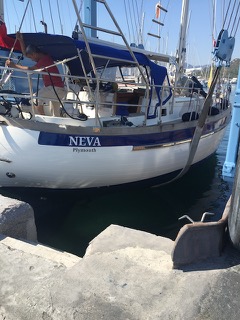

We refitted Neva with the benefit of two Atlantic crossings and 30,000 miles of two handed sailing so we got it fairly right!
Ade would still like a bow thruster, but we both agree that as we don’t go alongside that often the cost-to-benefit ratio probably does not justify fitting one.
The holding tank, as fitted in 1988, was probably OK then but is far too small for modern day cruising. If you are fitting holding tanks before you set off on your adventures, fit them as large as possible, it will be worth it.
We also kept too many old sails. Some spare sails are necessary but not a fore cabin full. When we got rid of the redundant canvas it went to a cancer charity that made sailcloth bags to raise funds, so they were put to good use in the end.

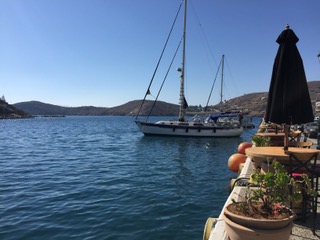
- Greece, Ios
List the countries you have cruised:
Turkey, Greece, Croatia, Corsica, Sardinia, Italy, France, Spain, Balearics, Gibraltar, Portugal, UK , Channel Islands, Madeira, Canaries, Cape Verdes, Greater Antilles, Lesser Antilles, Bahamas, US Eastern seaboard, Panama, Columbia, ABC’s.
Future cruising plans:
Remain in the Caribbean for two years with Neva, but work commitments may dictate otherwise. After that, we are still debating. Probably into the Pacific, health permitting, but we are not contemplating a circumnavigation…. well maybe not!
List the oceans/seas you have crossed: Mediterranean Sea, (3 years), Caribbean Sea (4 years), Atlantic Ocean (3 times).
Approximate sea miles: 46,000NM together, Ade has a further 60,000NM of prior experience.
Scariest day on the water:
Nearly being run down by a trawler while trying to stem a large leak from an incorrectly fitted bilge pump.
The two of us delivering the 75ft modern classic, which we were running, from Napoli to Lavagna in NW Italy. It was flat calm and we were motoring north when Sam said she could hear fast running water, and moments later one of the bilge alarms went off. Well, at least, as the bilges were compartmentalised we knew where to start looking! We lifted the cockpit sole and could see water syphoning back through the large manual emergency bilge pump into the bilge. A 2” hose can deliver water frighteningly fast! The pump was below the waterline, had no swan neck on the discharge, and a non return valve had jammed open.
It was a two handed task to detach the discharge hose and fit a softwood bung to stop the water flow (we had softwood bungs by all hull openings, please do not forget this important safety equipment).
With hindsight we should have stopped, but we had a deadline to meet for the boatyard to lift us that afternoon. We had checked that there was nothing in sight as we set to fixing our problem, but we had obviously taken longer than we thought, as we suddenly heard a ships siren and it sounded close. Ade leaped out of the bilges to see a trawler with nets towed right ahead. There was no time to disengage the autopilot so he just made a 50 degree course alteration and we missed the trawler by a couple of boat lengths.
Looking back on the incident we did two things wrong:
- We should have stopped instead of worrying about our ETA.
- We should have ensured that we took a regular look around, it would not have taken much longer to make the repair.

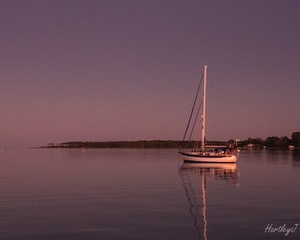
- Chesapeake, USA
Best cruising moment:
Seeing Madeira, 50 miles away, on our first proper offshore passage. We were still 8 hours out, but we entered Porto Santo at sunset and were greeted by a Portuguese family, who lent us keys to the showers and presented us with two bowls of a delicious local soup.
Favourite cruising area and why:
Lesser Antilles in general.
In the winter months the breezes are steady, the seas are smooth on the Caribbean side, and the anchorages are numerous. The slight downside is that too many others know this, and the popular anchorages can be over crowded.
Favourite anchorage:
Iles Fourchue, St Barts.
We hope this does not invite a huge number of new visitors!!! It is an extinct volcano with nothing ashore, but has good snorkelling and diving, and no light pollution at night. There is a small fleet of skippered charter catamarans which visit for one night per week – so this night is best avoided.

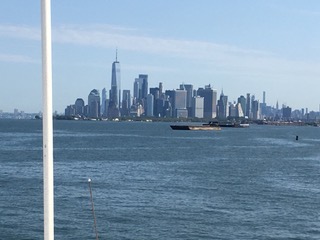
- Manhattan skyline
Favourite cruising apps:
- Navionics on the iPad
- Nightsky 2 on the iPad
- Imray Tides Planner on iPad
Favourite cruising websites:
- Noonsite
- Ocean Cruising Club (even if you are not yet a member there is a lot of useful information on the public pages)
- Marine Traffic or Vessel Finder
- Windy and Windguru
- NOAA
Favourite cruising books:
- World Cruising Routes, Jimmy Cornell
- Heavy Weather Sailing, Adlard Coles
- Cooking Afloat, Fiona Grafton
- Cruising Under Sail, Sue and Eric Hiscock (This is Ade showing his age, but they came from Yarmouth Isle of Wight where he was based for all his early sailing years)

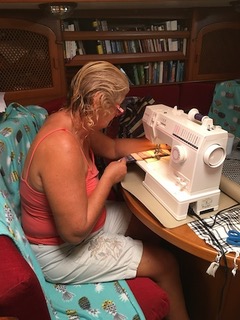
- Making curtains.
What advice or message would you want to pass on to anyone new to cruising or thinking about casting off the dock lines?
DO IT!!
Seriously, we have met many, many, cruisers of all ages. Some have young families and home school, some are retired and enjoying the escape from normal life. All have their own goals and aspirations.
A few pointers from our observations over the last 9 years:
- Prepare yourselves and your boat to cope with the type of cruising you have in mind. Don’t imagine that you and your boat will be perfectly ready to set off, or you will never leave. We categorise preparedness into:
– Safety Critical (do not go)
– Inconvenient (go but accept the inconvenience)
– Luxury (just get on with it!) - Give yourselves realistic targets. We wanted to do a North Atlantic circuit, which was what we were comfortable with, taking into account age and experience (mainly Ade’s in the early days).
- Check out whether you can obtain insurance. This is becoming more difficult these days, especially for less experienced crews or for two handed ocean voyages. We were able to obtain two handed trans ocean insurance, but we had to complete the passages from the UK to Cape Verde as a couple before we received approval for our ocean crossing.

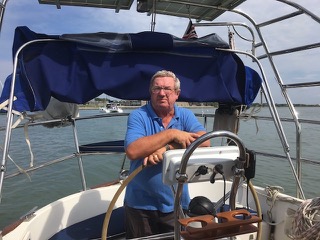
- Ade concentrating before we went through half of the Bridge of Lions at St Augustine, FL
One last thought – the most common complaint we hear from owners and crew alike are the problems of compatibility (or lack of it) with crew on long passages. If you need, or want to take additional crew, be very careful with your selection process. We can even cite examples of great friends ashore falling out permanently on long passages.
We once had to recruit an additional crew at short notice, on the owner’s insistence, for a passage from NW Italy to Gran Canaria. A fellow skipper offered one of his crew as he was not on charter for a few weeks. We were not told that this guy was the cook and host! We had to remove him from the watch bill if we were under sail as he didn’t understand anything about sailing, and Ade had to order him at one stage to take a shower and change his clothes. Sam did, however, get a proper Italian Lasagna recipe, and the stainless and brightwork was perfect on our arrival.

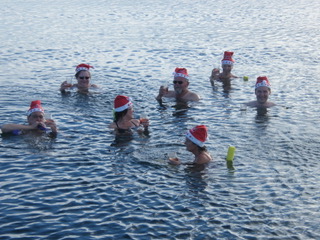
- Panama Christmas
Why cruise? In a few sentences, what is it that inspires you to keep cruising?
For us, we enjoy new places, but mostly it is the people we meet that make this lifestyle so special. We have made very many special friends over the past nine years, There is something special about sailing into a bay and seeing another boat that you last saw many miles previously, although AIS has taken away some of the surprise!
Any other comments:
As you have seen, we mix work and pleasure. We mostly work operating other yachts, but Sam is a Dive Master and Ade is an Electrician so we have other sources of income in countries where we are permitted to work.
We are both RYA Yachtmasters, Ade Ocean and Sam Offshore. If you want to work in the Charter world you will also need to complete the STCW 10 courses, hard work but also a lot of fun. Live fire fighting and life raft drills are part of the curriculum. Some of the super yachts will not let you aboard, even in harbour, without STCW qualifications!
If you are in the position where you need additional income on your travels, think about your
combined skill sets. We came across an excellent welder who had never considered using those skills while cruising to provide an income. Just ensure that you stay legal in any country in which you work. Always ask around, especially among the cruisers, to establish the local situation. In some places deliveries or charter activities are considered as “offshore work”
There is no better place than the cruiser’s Happy Hour Bar to gather information. Over the last 9 years we have only got one job from advertising or crew agencies, everything else has come from word of mouth, so the importance of social networking cannot be over-stressed.
We have been asked what the ratio of work to leisure tends to be. There is no real answer to
this. We will take as much work as we can get as you never know where the next opportunity
will turn up. We have struggled over the last few months as the industry has really suffered
with the Covid 19 restrictions, but we had a huge amount of work leading up to the restrictions so we have survived. You have to be willing to take the rough with the smooth!
Sam and Adrian Wood
SV Neva
…………………………………………………………………………………………………………………………………..
Related content:
Portrait of a Cruiser Cruising Resources Page
…………………………………………………………………………………………………………………………………..
We would love you to take part in this series and share your cruising story with other Noonsite users. If you would like to take part, please contact Sue at editor@noonsite.com with some details about yourselves and your cruising and to request a questionnaire.
…………………………………………………………………………………………………………………………………..
The opinions expressed in this article are the author’s own and do not reflect the view of Noonsite.com or World Cruising Club.
Related to following destinations: United Kingdom
Related to the following Cruising Resources: Portrait of a Cruiser






